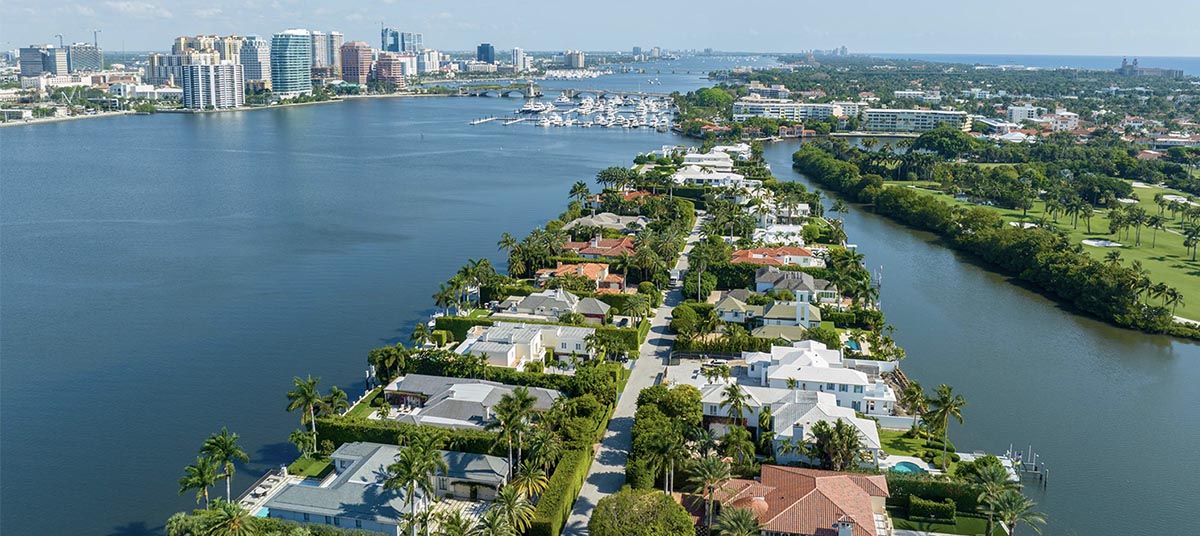Blog
We keep you up to date on the latest tax changes and news in the industry.
Inside the Tax Hike During Palm Beach's Real Estate Boom

Palm Beach, historically a sanctuary for the affluent, now finds itself at the center of a tax surge paralleling its real estate market's explosive growth. A Bloomberg study reveals that over 31 properties now endure annual taxes exceeding $1 million, a marked increase from merely seven before the pandemic took hold. The influx of wealth along Ocean Boulevard has not only captured attention but also fortifies local budgets.

Opulent Tax Strategies
In the previous year, property-tax revenues throughout Palm Beach County soared to $359 million, a staggering 75% rise since 2018. With no state income tax in Florida, this revenue bonanza sustains vital public utilities and infrastructure. However, the outcomes of this financial transformation extend farther than most anticipate:
“This emerging cadre of super-wealthy Palm Beach denizens is contributing significantly to the town’s cash flow…”
These properties transcend typical luxury homes, presenting as opulent mega-mansions, privatized islands, and undisclosed compounds bolstered by lush hedges and secure barriers. Tax invoices exceeding $10 million are now part of the landscape, with hedge fund mogul Ken Griffin reportedly facing one of the most substantial tax liabilities.
Pandemic-induced Real Estate Surge
Palm Beach's real estate upheaval didn't occur overnight. The post-pandemic era ushered an influx of high-net-worth individuals chiefly from New York and coastal areas. From 2019 to 2024, home prices escalated 89%, with ultra-luxury estates ($20 million+) rising 500%. Listings surpassing $10 million experienced a 400% increase as well.
Palm Beach, once a tranquil retreat for historical elites, has transformed into a perpetual haven for hedge fund magnates, crypto aficionados, and tech entrepreneurs trading their urban dwellings for seaside palaces. In some scenarios, properties don't even enter the MLS—buyers arrive, conduct private tours, and immediately transact millions without hesitation. “This isn't merely a boom," remarked one luxury agent. “It represents a seismic shift within the nation's tax ecosystem, outlined by zip codes.”

Affluent New Yorkers are trading metropolitan apartments for coastal estates, drawn by Florida’s tax advantages, enduring sunshine, and Palm Beach's newfound renown as more than exclusive, but essential. This evolution has fueled exceptional property value enhancements, catalyzing novel construction, aspiration, and social maneuvers unfolding on every curated lawn.
Secret Estates & High-Stakes Deals
The luxury property scene in Palm Beach bears similarities to thriller narratives. A mysterious investor—maybe Microsoft tycoon Charles Simonyi—has been discreetly assembling a $250 million+ oceanfront complex north of Mar-a-Lago, rapidly acquiring neighboring properties. In a noteworthy event, the investor sought to purchase Jon Bon Jovi's residence, only to be denied with a dose of rock-star audacity as reported by The Wall Street Journal.
This evolving drama mirrors headlines from popular series: whispered offers, NDA-guarded dialogues, and billionaire chess strategies unfolding behind doubled hedgerows and estate gates.
Concurrently, Ken Griffin, Citadel's architect and de facto luminary of Florida real estate, is progressively building his Palm Beach kingdom. His expansive holdings now span multiple premier spots, potentially challenging Mar-a-Lago's stature and promising a tax tally that could unsettle many developers.
Skyrocketing Values & Expanding Infrastructure
Beyond luxury estates, Palm Beach County's real estate trajectory includes a broader array of developments. As of 2025, new developments injected over $5 billion into tax assessments, raising total taxable worth to $341 billion, a 62% increase from 2020.
This expansion extends to places like West Palm Beach and Palm Beach Gardens, where newly framed condominium towers, elite rentals, and versatile complexes rise, reshaping the horizon almost instantaneously. Malls evolve into plazas and once slow-paced streets boast upscale grocery venues, chic rooftops, and multi-million dollar listings.
This boom, propelled largely by out-of-state migration from high-tax regions, presents not just capital but instigates both a cultural and architectural rebirth within the area.
Balancing Public Gains & Infrastructure Demands
The increased tax inflow positions Palm Beach County amidst economic prosperity—but not devoid of hurdles. Enhanced public resources enrich residents' lives, yet infrastructure demand also climbs. Schools, roads, and emergency services are challenged to keep pace with a community peaking seasonally with high tax contributors.
Policy leaders strive for balance: attracting revenue while ensuring luxury doesn’t overshadow the quality of life.
Key Implications
For Policymakers: This financial gain creates prospects for enhancement—from coastal defenses to school expansions—while curtailing inequality.
For Residents: Services may improve imminently, but tax assessments entail elevated expectations and apprehensions about overbuilding.
For Buyers: The market stays ebullient, albeit with tax duties that match or exceed the homes’ upfront costs.

As Palm Beach transforms from a seasonal retreat to a permanent hub for billionaires, its taxation framework vividly tells a narrative of abundant revenue juxtaposed with intricate ramifications.
Sign up for our newsletter.
Each month, we will send you a roundup of our latest blog content covering the tax and accounting tips & insights you need to know.
We care about the protection of your data.